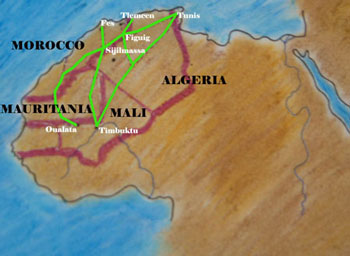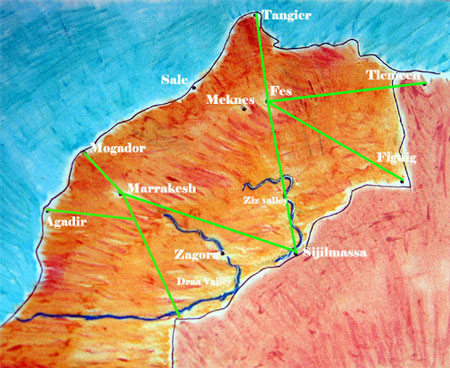The caravan trails: a trade route
 This
trip takes us along the caravan trails: routes taken by caravans through
Morocco, to or from the desert.
This
trip takes us along the caravan trails: routes taken by caravans through
Morocco, to or from the desert.
For centuries
caravan travel was the central means of transportation for goods traded
between the Mediterranean and the Sudan. Cloth, salt, metals, pearls
and writing paper were brought from Europe and the Maghreb into present-day
Mali, where they were exchanged for gold, slaves, ivory and ostrich
feathers.
These
caravans were led by nomadic desert tribes: middle-men whose leverage
lay in their knowledge of the land and ownership of camels- "the
vessel of the desert".
 Camel
caravans (or should I say dromadery
caravans) first started operating in the 3rd century A.C.; the
last caravan routes were closed down in 1933.
Camel
caravans (or should I say dromadery
caravans) first started operating in the 3rd century A.C.; the
last caravan routes were closed down in 1933.
Leo traveled along these caravan routes, into the Saharan desert and
to Timbuktu twice- once as a young man, accompanying his uncle on
an embassy to visit the sultan of the Sudan; and once a few years
later, on a longer trip through what was then known as "Black
Africa".
Today's political situation in Algeria and Mauritania make it difficult
for travelers to follow these ancient caravan trails fully- this trip
will bring you along these routes through Morocco, to the three "gateways
into the desert" : Figuig in the South East and Sijilmassa and
the Draa valley in the West. As Leo did 4 centuries before us, we
will follow the two most common itineraries through Morocco:
-the route
of the East: From Fes to Figuig, then to Sijilmassa
-the route of the West: from Marrakech to Zagora and down the Draa
valley.
Join the Caravan to learn more about Camels, deserts and traveling
habits of the 16th century!